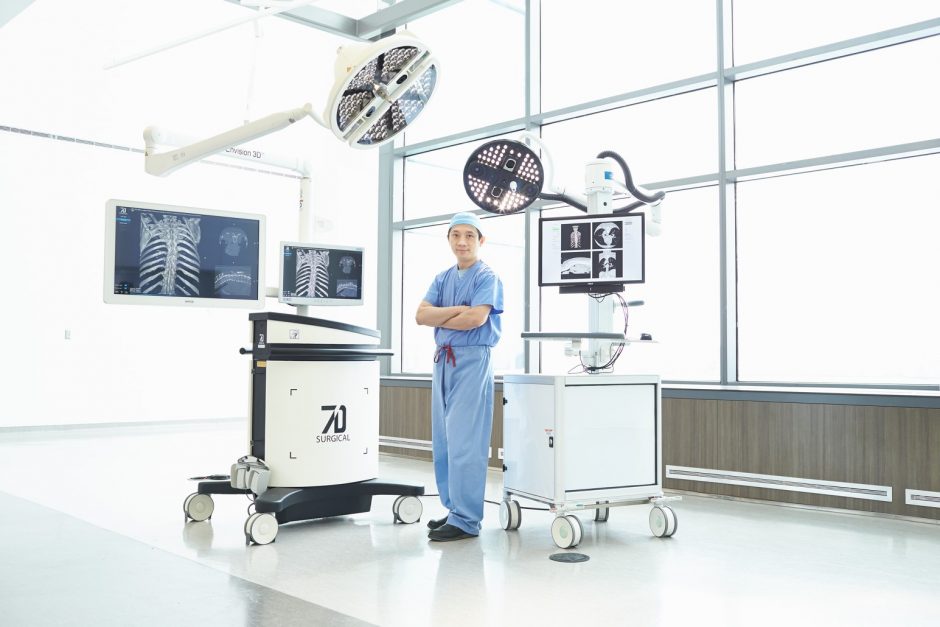In this interview, we talk with Dr. Victor Yang, a co-investigator from the image-guided delivery team helping to realize the vision of Mend the Gap.

Tell us about yourself!
I am a surgeon-engineer specializing in translational device development research, with the goal of moving novel and emerging technologies from ideation to clinical practice, and with particular focus on neurosurgery. Presently, I am a Professor of Surgery at Western University, a Staff Neurosurgeon at London Health Sciences Centre, and a Professor in Electrical, Computer, and Biomedical Engineering at Ryerson University. My focus is on technologies that enable clinicians to move beyond the limitations of the current state-of-the-art, with particular specialization in image-guided therapeutics.
What are the major risks in injecting gel materials into the spinal cord?
Injecting any material into the spinal cord will of course come with significant risks. When a spinal cord injury (SCI) occurs, the current best practice is to wait and observe how a patient recovers, and to determine the extent of damage once some healing has occurred. Often, the patient is relying on nerve fibers that have not been damaged to return some level of function to affected areas. For this reason, injection will have to be incredibly accurate – both with respect to location and amount of material delivered, as inaccuracy in either of those areas could damage those spared fibers, thus creating greater deficits for patients experiencing spinal cord injuries. It is for this reason that the use of customized, image-guided techniques will be crucial to minimizing this risk.
What is the current state of technologies that exist to achieve gel injection?
Presently, there are no specific technologies that exist to meet this task. While there is ongoing international research that is geared towards treatments for spinal cord injuries, many of them are still in pre-clinical stages, and none can fully address the minimally-disruptive injection envisioned in Mend the Gap. The novelty in this project rests in the integration of image-guided methods, which have been tested separately to various degrees, but have not been combined for this specific task. Our work will build upon technological platforms that have already been developed, and integrate systems to create a customized solution that can best meet the needs of this treatment. From the image-guided surgery perspective, this will involve taking the current state-of-the-art in neurosurgical robotics, and expanding on these capabilities. This would include integration of imaging modalities, such as optical coherence tomography, ultrasound, and fluorescence for both guidance and motion compensation. At its core, this proposal uses these foundational technologies in order to build a new, robust, robotic and injection platform that can safely deliver biomaterials in the lesion.
How does Mend the Gap align with the long-term vision for treating spinal cord injury?
Mend the Gap is the foundation for a larger project that could have a substantial impact on SCI and beyond. The project aims to create a number of novel technologies that have the potential to change how we treat SCI, and ideally, at the end of the 6-year project, we will see these technologies aligned and ready to move to late pre-clinical or even first-in-human trials. The impact of that cannot be understated. In the future, we would be looking to further refine the technologies, prove safety, and demonstrate clear evidence in support of beginning and continuation clinical trials. As these advantages are demonstrated, it is important that there is engagement and buy-in at all levels of the process – from the clinicians, individuals with SCI, community organizations, and healthcare systems, which will support adoption and acceptance of the new procedure.
What drives you to innovate in this space, and where does your passion come from?
My drive and passion for my work comes from working with exciting technologies and the brilliant minds of my peers and students. As a practicing neurosurgeon, I have the opportunity to see first-hand how the innovators of the past have had such impact on patients, and can offer hope and help in even the darkest of times. In that same way, as an engineer, I can see how much further we have to go, and how much more innovation is needed to continue to advance patient care, and to offer new hope for patients. Having the opportunity to work within an interdisciplinary environment, where innovators in all areas come together to meet the grand challenges presented in medicine, can be some of the most enthralling and energizing experiences.